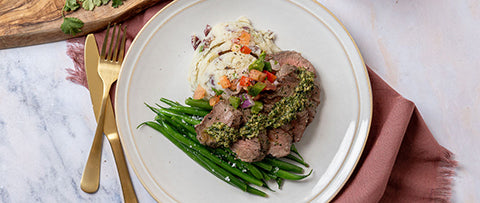I was always chewing gum, drinking diet soda, and eating those 100 calorie snack packs. Anything to feel like I was enjoying carbs without all the calories.
I weighed myself daily, this was always in the morning, first thing after I went to the bathroom on an empty stomach when I would be the lightest. I searched out high fiber foods since I would be able to subtract fiber from carbs to get my “actual net carb” count for a snack or meal. I was so strict with my food, I wanted to be so fit. I felt like I had to be perfect with my food because I was the personal trainer, I could show no weakness. I’d sneak ice cream at night so my boyfriend wouldn’t see.
I wasn’t losing weight, though, and I definitely wasn’t happy. I had a terrible relationship with food. I knew there had to be a better way.
That was 10 years ago--before I decided to trust real food.
When I finally decided to “trust the process,” and give quality food a chance (rather than eating mountains of low-calorie, processed foods/drinks), I drastically improved my relationship with food, lost over 20lbs, and have sustained my results ever since. I look the best I ever have in my life, I look forward to meal times, I have more energy than ever and I’m confident that I’m setting a healthy example for my kiddos.
In this blog, I’m going to share with you what quality food means, how it can impact your weight loss, and how to make sure you’re eating quality food as part of a healthy life.
What Quality Food Means
Quality food means real, minimally processed food that your body knows how to digest and use as fuel. It’s usually slow digesting, nutrient dense, and leaves you feeling full and energized.
It usually doesn’t contain, or is very limited in: preservatives, artificial flavors and colors, refined sugars, hormones, and antibiotics. That kind of food often goes through a lot of processing before it gets to you, and along the way has other things added to it to extend the shelf life or taste.
Let’s look at a few examples of real, quality food vs. food that is nutritionally lacking:
Carbohydrates
Quality carbohydrates are slow digesting, complex, contain fiber, and will leave you full and energized. A few examples of quality sources include whole grains, fruit with the skin on, starchy and fibrous vegetables, and legumes.
Lower quality carbohydrates are usually quick digesting, simple, and spike your blood sugar levels, leaving you tired and hungry again soon after. Examples include refined breads and grains, refined sugars, and things like candy and soda.
Protein
Quality sources of protein are lean, hormone and antibiotic free, and help us build and maintain muscle. This would include things like chicken or turkey breast without the skin, lean cuts of steak, Greek yogurt, fish, eggs, nuts, seeds and legumes.
Lower quality protein usually contains lots of gristle or saturated fat, such as a fatty cut of steak. It could also contain hormones and antibiotics, which get passed on to you.
Fat
The best sources of fat are unsaturated fat. These fats protect you against heart disease, aid in brain and eye function, and help slow digestion; unsaturated fats come from things like olive oil, salmon, eggs, avocados, nuts and seeds.
Another kind of fat that provides some health benefits are saturated fats. These aid in cell membranes and hormone function, but also increase bad cholesterol so it’s best to consume these in moderation. These come from things like animal fats including steak, cheese and butter.
Lastly, the lowest quality kind of fat is trans fat. These fats not only increase bad cholesterol but also decrease good cholesterol. They are added to foods to extend shelf life and flavor, and are commonly found in things like baked pastries and fried foods. You want to limit trans fats as much as possible to live a healthy life.
To review, quality food means real, minimally processed food that your body knows how to digest and use as fuel. It’s usually slow digesting, nutrient dense, and leaves you feeling full and energized. Next, let’s look at why the quality of your food matters to lose weight and live a healthy life.
Why Quality Food Matters
Doesn’t your food just need to fit your macros?
The right balance of macronutrients is essential to reaching any weight loss goal and living a healthy life, but in my experience that’s only part of the equation. Let’s look at what happens when you eat low quality food vs. real food.
What happens when you eat “diet” food
When I lived off of diet-everything, there was a traffic jam in my body. My body didn’t know how to use those things as fuel. I was bloated, cranky, and constantly had cravings.
Those lower quality foods, like artificially sweetened gum, diet sodas, and low fat cool whip, are low in calories which allowed me to eat more volume, but I never felt full. That’s because I was missing micronutrients from real food sources that are important for satiety and metabolism. Without real fuel for my body to use I became hungry again soon after eating.
By the end of the day I was starving. I would binge eat ice cream at night and start the process all over again the next day.
Let’s contrast this with what happens now that I eat real, quality food.
What happens when you eat real food
When I finally committed to real, quality food, my body knew what to do with it. To be honest I was scared but I knew there had to be a better way, and I was so unhappy that I was willing to try anything.
I started incorporating things like salmon, avocado, oats, full fat dressing *gasp* and nuts, eggs with the yolks, different kinds of proteins like bison, shrimp, chickpeas, black beans, and new carbs like quinoa, forbidden rice, potatoes, and fruits and vegetables I previously shunned because I thought they had too much sugar--bananas, carrots, mango, beets, tomatoes, pineapple, grapes, and apples.
My body was finally getting the nutrients it needed. I learned how to eat appropriate portions of carbs, fats, and proteins and stopped eating when I was full. I learned what it felt like to be nourished and satiated, and that allowed me to begin to eat more intuitively and simply listen to my body rather than feeling like I was fighting my body.
I got excited to try new foods, to go grocery shopping, to cook, and to experience a new dish, combining the different spices and flavor elements. I started to look forward to meal times. My anxiety around food subsided.
Combined with portion control, exercise 3-4 times/week, and patience, 20lbs fell off. It’s stayed off ever since.
So, quality foods are nourishing, satiating, and help prevent us from over-eating later in the day or week. Lastly, let’s look at a few strategies to make sure you’re getting quality foods in your diet.
How to Get Quality Foods in Your Diet
We know what quality foods are and why they matter, now let’s talk about how to make sure you’re eating quality foods so you can make progress toward your weight loss goals and live a healthy life. I recommend you check the nutrition facts label, read the ingredient list, and shop at places you know and trust.
Check the nutrition facts label
In regards to quality ingredients, when you look at the nutrition facts label you’ll want to check for things like unsaturated fats, saturated fats, trans fats, fiber, and added sugar to help determine the quality of the food. Remember, quality fats will be higher in unsaturated fats, lower in saturated fats, and likely won’t contain any trans fats. If it’s a carbohydrate, it will be higher in fiber and starch and lower in added sugar. Quality proteins will be low in fat.
The nutrition facts label doesn’t tell the whole story though, so you’ll need to look at the ingredient list.
Read the ingredient list
The ingredient list will tell you where the nutrients on the nutrition facts label are coming from. It’s your best source of information when searching for real, quality food.
A good indicator is ingredients you know and can pronounce. When in doubt, look up an ingredient you’re unfamiliar with to determine if you want to consume it.
It’s also great if your food doesn’t have a label on it, like fresh produce. That means it’s just one ingredient!
Shop where you know and trust
If you need help cooking, if you can’t find the time or you just know you’re not going to do it, I recommend using fit-flavors to help make eating quality food a habit.
Not only will you actually be consuming more quality food than you would on your own, you’ll also learn what proper portions are so you can make healthy choices elsewhere. In time your body will start to crave healthy food!
Quality food is nutrient dense, minimally processed and leaves us satiated and energized. It nourishes us so our cravings are minimized, and it enables us to have a healthy relationship with food, reach our weight goals and live a healthy life. You can incorporate quality foods into your diet by reading nutrition facts labels and ingredient lists, and shopping at places you know and trust.






